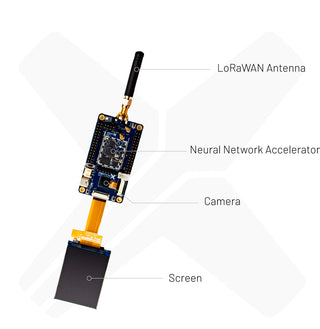MatchX releases multi-faceted EdgeX AI Dev Kit, bringing edge artificial intelligence to LPWAN whilst maintaining people’s right to privacy.
Berlin-based LoRaWAN manufacturer MatchX released the EdgeX AI Development Kit, set to improve both LoRaWAN and NB-IoT capabilities around the globe. EdgeX has been specifically designed to be programmed with an embedded artificial intelligence capable of analyzing everything from human emotions to city traffic patterns and street maintenance requirements. Unlike other devices, EdgeX completes its analysis on the device, transmitting the analysis results over a LoRaWAN or NB-IoT connection to ensure the utmost privacy of passersby.
“By ensuring that no data is stored on the device and only the results of the AI analysis are transmitted to the cloud, we provide companies with a headstart on privacy, especially when building GDPR compliant solutions.” LoRaWAN and NB-IoT are low-power wireless solutions with limited bandwidth. Because of this, sensors using these networks can function for up to ten years on a single battery. These devices, however, are incapable of transmitting a live video or audio feed for server-side analysis. This, previously seen as a disadvantage of these networks, is a valuable asset when considering data privacy.
LoRaWAN and NB-IoT are low-power wireless solutions with limited bandwidth. Because of this, sensors using these networks can function for up to ten years on a single battery. These devices, however, are incapable of transmitting a live video or audio feed for server-side analysis. This, previously seen as a disadvantage of these networks, is a valuable asset when considering data privacy.
“Privacy is a major concern for citizens and therefore smart city projects around the globe,” said MatchX Co-Founder and CEO Sheen Xin Hu. “By ensuring that no data is stored on the device and only the results of the AI analysis are transmitted to the cloud, we provide companies with a head-start on privacy, especially when building GDPR compliant solutions.”
The EdgeX AI Dev Kit is a unique development platform for applications requiring visual or audio data processing and feature extraction combined with long-range radio connectivity. It is built around MatchX AI System on Module (SoM) which combines Kendryte K210 dual-core RISC-V processor and a Semtech SX1261 LoRa transceiver. This device is perfectly suited for applications requiring edge computing of audiovisual data with low energy consumption. The results of the data analysis can be transferred using the embedded LPWAN transceiver.
Artificial Neural Networks & low power consumption
“One of the factors limiting AI adoption is the power consumption of the hardware running Artificial Neural Networks (ANN),” said MatchX Co-Founder and CTO Piotr Brzeziński. “The new MatchX AI system on module (SoM) provides hardware acceleration of ANN and lowers the power consumption.”
The EdgeX AI Kit can cope with vast amounts of data generated by IoT sensors and connects seamlessly with both the MatchX LPWAN Ecosystem and NB-IoT networks. The MatchX LPWAN Gateway provides low-power, long-distance connectivity for transmitting processed data from AI Kit to the MatchX Cloud. Leveraging edge computing reduces latency in analytic processing and boosts overall network performance.
MatchX bridges the world of public data with cities, businesses, and individuals, making data more accessible by placing it at the core of decision-making policies, ensuring an improved world of tomorrow.
For EdgeX AI project consultation please send an email to awesome@matchx.io.
MatchX CEO Sheen Xin Hu and CTO Piotr Brzeziński are available for interviews upon request.
About MatchX GmbH
MatchX provides a revolutionary breakthrough to the IoT industry and the world’s data needs, an end-to-end network solution that ensures increased data efficiency whilst reducing energy consumption and significantly reducing costs. MatchX hardware operates on LPWAN (Low Power Wide Area Network) technology, which can connect sensors over long distances while offering optimal battery life and requiring minimal infrastructure.
About the LoRaWAN
The LoRaWAN® standard is a Low Power Wide Area Networking (LPWAN) protocol designed to wirelessly connect battery operated ‘things’ to the internet in regional, national or global networks to deliver actionable data and improve efficiencies. It targets key Internet of Things (IoT) requirements such as bi-directional communication, end-to-end security, mobility and localization services.

